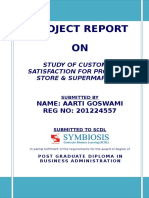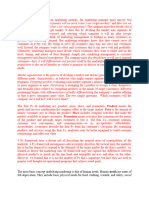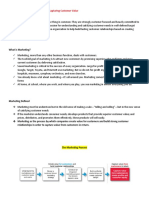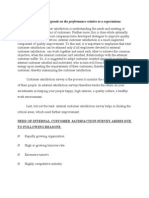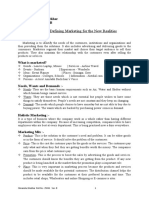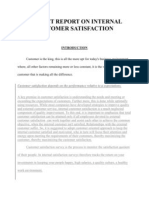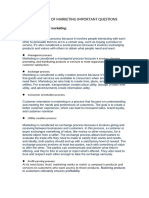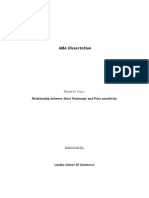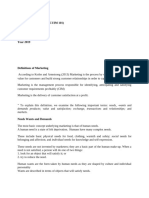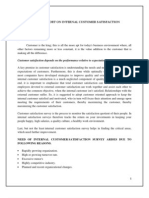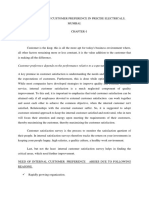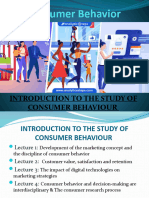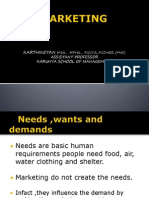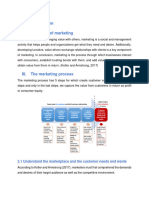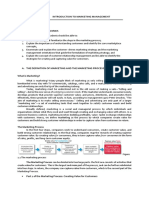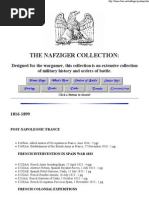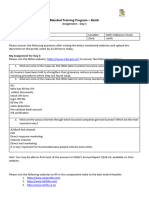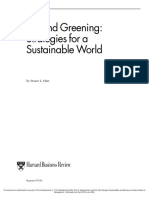About The Topic
About The Topic
Uploaded by
JUSTINE0077Copyright:
Available Formats
About The Topic
About The Topic
Uploaded by
JUSTINE0077Original Title
Copyright
Available Formats
Share this document
Did you find this document useful?
Is this content inappropriate?
Copyright:
Available Formats
About The Topic
About The Topic
Uploaded by
JUSTINE0077Copyright:
Available Formats
ABOUT THE TOPIC
Customer Satisfaction Customer satisfaction is a persons feelings at pleasure or disappointment resulting from comparing a products perceived performance in relation to his or her expectations.
PHILIP KOTLER, marketing management, New Delhi, prentice Hall at India Pvt.Ltd, 1998, 9th edition.
Business has started releasing it. Earning profit is possible only through the customer satiscation. To satisfy that the customer their needone to be known order customer oriented marketing it becomes essential to know what the customer needs. This is only when information is collected from the customer needs. The marketer must see that customer with purchasing power constitute a potential market no sales can be made unless the customer. It is essential for the marketer to carry out the business in such a way that they give in many case customers need at a profit. In many case customers are ignorant about their needs, the marketer adopts the customers point of view and tries to make what they can sell. But now to sell what they can make. They become customer oriented. customers. A manufacturer should study about customer satisfaction in relation to there need desire and then design to make the taste of to
Secondly, customer does not buy the products services themselves. But for the pormiseof these purchases will do for them. Thirdly, the basic consideration, customer have unlimited desire but with limited purchasing the power while buying a customer choose the best produce at a reasonable price, which is based upon the objectives of pricing policies. Fourthly, customer images, while buying the customer is greatly influenced by their images of the brands of various competing sellers, tehj brand images and products personlities, for instance design colour package price etc.
CUSTOMER SATISFACTION OF SERVICES The service of a firm on the following five terms are: 1. Tangibles, i.e., the appearance of physical facilities equipment, personal and communication material. 2. Reliability, i.e., the ability to perform the desires, services, dependability and accuracy. 3. Responsiveness, i.e., the willingness to help customer and provide prompt services. 4. Assurance, as measured by compartence of the firm to deliver promised service depending and accurately. 5. Empathy, the caring and individualized attention that the firm provides to its customers.
It is important to note that the customer satisfaction is a dynamic force with potential to fuel self reinforcing relationship with the firm. An increased customer satisfaction through high service quality delivered by a firm leads the customers to increase usageof the firms service relative to its comperitors. To create this self reinforcing process one has to appreciate that there are two important players in a firms profitability generation i.e., the customer and the firm itself. It is also a fact that the firm has to invest higher resources in improving the services quality unfortunately may firms in India still drag their feet on these dimensions and therefore customer friendly policies and to be adopted to make the services customer oriented. We need to appreciate that these customer friendly polices motivate and empower the employees to serve customer better and there by deliver premium quality of service, which only helps the firm to increase sales volume, get a price premium and maximize profits and market scheme. Modern marketing The procucers of the last century had littlefor the customer, now the production is carried on in large quantity, the manufacturer profucers more than what he society needs, the marketer appears in the market and more arise competition. The customer, who comes in the last stage, accepts the goods, there is as alternative but the situation was changed, market has developed from national to intenational competition is the order ofr tahe day. Being with the customer and end with the customer, marketing research starts at the stage, though market research information of current needs can be known. Levity instead of focusing tyo market what is easiest for us to make we must find out much more about what the customer is willing to buy. In other works. We must apply our creativeness more intelligently to peo;oe and their want and needs reather than to products.
Marketing Research: Marketing research is defined and the systematic, objectives and exhaustive search for the study of the facts relevant to any problem in the field of marketing. Marketing research may be described as a method of getting facts to be described as a method of getting facts to be described as a method of getting factors to be used by the executive in formulation policies and plans it can be defined as the systematic search of information. It involves data collection research cannot draw decisions, analysis and interpretation, but it helps the markets in the task of decision-making, a successful executive will never depend upon guess work. He looks for more accurate information through research. The main idea of marketing research is to know more about the consumers, declares and producer, as the business grows, the distance between the manufacturer and consumers also widens. The management depends upon the marketing research as a tool is solving the marketing problem. It help;s in taking a faithful an efficient decision as to the flow of goods and sevices in the hands of two customers. The research mainly focuses the study to determine marketing is th total system business activities designed to plan price, promote and distribute want satisfy goods and services to present and potential customer. Customer perceived value: Our premise is that customers will buy from the firm that hey see as offering th highest perveived value. Customer perceived value (CPV) is that is the difference
between the prospective customers evaluation of all the benefits and all the costs of an offering and the perceived alternatives. Total customer value is the perceived monetary value of the bundle of economic, functional, and psychological benefits customers expect from a given market offering. Total customer cost is the bundle of cost customers expects to incur in evaluating, obtaining, using and disposing of the given market offering.
You might also like
- Store & Supermarket ProjectDocument112 pagesStore & Supermarket Projectshobhit85% (13)
- Swaraj Tractor in Full ReportDocument57 pagesSwaraj Tractor in Full ReportMeena Sivasubramanian50% (2)
- Chapter 4 & 5Document115 pagesChapter 4 & 5Kebede ChallaNo ratings yet
- Chapter 3 &4Document98 pagesChapter 3 &4Kebede ChallaNo ratings yet
- Airtel Customer SatisfactionDocument88 pagesAirtel Customer SatisfactionRaghuRavula60% (5)
- Chapter-1 Definition of Marketing For 21st CenturyDocument12 pagesChapter-1 Definition of Marketing For 21st CenturyTrifling TechNo ratings yet
- Answers - QuizDocument4 pagesAnswers - QuizadilkhanNo ratings yet
- Chapter 1. Marketing Creating and Capturing Customer ValueDocument6 pagesChapter 1. Marketing Creating and Capturing Customer ValueAnna PanteNo ratings yet
- Chapter 1 Introduction Customer SatisfactionDocument9 pagesChapter 1 Introduction Customer SatisfactionAkhil CrastaNo ratings yet
- Principle of Marketing (Chapter 1)Document14 pagesPrinciple of Marketing (Chapter 1)adamu shumetNo ratings yet
- Fmea Unit2Document78 pagesFmea Unit2aschandrawat357No ratings yet
- Customer Satisfaction Depends On The Performance Relative To A ExpectationsDocument8 pagesCustomer Satisfaction Depends On The Performance Relative To A ExpectationsRupesh DeyNo ratings yet
- CH 05 Marketing and New Venture DevtDocument10 pagesCH 05 Marketing and New Venture DevtWondmageneUrgessaNo ratings yet
- LO1 MarketingDocument6 pagesLO1 MarketingBashar AlfyNo ratings yet
- Chapter 1 Defining Marketing For The New Realities: Name: Himanshu Shekhar Roll No: 25061 Sec: BDocument4 pagesChapter 1 Defining Marketing For The New Realities: Name: Himanshu Shekhar Roll No: 25061 Sec: Bhimanshu shekharNo ratings yet
- PP P P PPP PPPPPPP PP PPPPPP PPP PPPP P PPPPPPDocument24 pagesPP P P PPP PPPPPPP PP PPPPPP PPP PPPP P PPPPPPRashi Gaurav SambhawaniNo ratings yet
- MariameDocument4 pagesMariameelpreciso.10No ratings yet
- Answers - QuizDocument4 pagesAnswers - QuizadilkhanNo ratings yet
- Assignment MarketingDocument6 pagesAssignment MarketingJanisar Ali BhuttoNo ratings yet
- Principles of Marketing Important QuestionsDocument29 pagesPrinciples of Marketing Important Questionssharanmsd7No ratings yet
- Principles of Marketing 1Document10 pagesPrinciples of Marketing 1Youmna007No ratings yet
- Answer For Test IiDocument6 pagesAnswer For Test IiDianne DiezmoNo ratings yet
- A Study On Customer Satisfaction of FMCG in Pathanjali ProductsDocument13 pagesA Study On Customer Satisfaction of FMCG in Pathanjali ProductseswariNo ratings yet
- Research ProjectDocument73 pagesResearch ProjectMd KarimNo ratings yet
- Chapter Five Marketing and New Venture Development 5.1 The Marketing PerspectiveDocument8 pagesChapter Five Marketing and New Venture Development 5.1 The Marketing Perspectivehussien amareNo ratings yet
- Unit 1 SalesDocument19 pagesUnit 1 Salessaurabh thakurNo ratings yet
- Principles of MarketingDocument6 pagesPrinciples of MarketingMariam ShaheenNo ratings yet
- Wa0001Document33 pagesWa0001hwezvamunyaradziNo ratings yet
- Marketing Management AssignmentDocument7 pagesMarketing Management AssignmentKirwa NickNo ratings yet
- Marketing Mix BOM Assignment 1Document4 pagesMarketing Mix BOM Assignment 1Nidhi ShahNo ratings yet
- Marketing and Customer Value - Terney KathDocument3 pagesMarketing and Customer Value - Terney KathDanielle Edenor Roque PaduraNo ratings yet
- Project Report On Internal Customer SatisfactionDocument13 pagesProject Report On Internal Customer SatisfactionNeha RoyNo ratings yet
- 8 Marketing ManagementDocument146 pages8 Marketing ManagementAadarshini Gupta100% (1)
- Definition and Evolution of Marketing ManagementDocument13 pagesDefinition and Evolution of Marketing ManagementMinatoNo ratings yet
- Customer Preference Depends On The Performance Relative To A ExpectationsDocument15 pagesCustomer Preference Depends On The Performance Relative To A ExpectationsMeena SivasubramanianNo ratings yet
- Solution To Chapters 1& 2Document17 pagesSolution To Chapters 1& 2Nowsheen Noor100% (1)
- Consumer BehaviorDocument38 pagesConsumer Behaviorlucyheartfealia27No ratings yet
- 7 P'sDocument20 pages7 P'sJan PlazaNo ratings yet
- Unit 8 (Iim)Document14 pagesUnit 8 (Iim)akashNo ratings yet
- NOTES - Marketing MGMTDocument92 pagesNOTES - Marketing MGMTPrabhuNo ratings yet
- Marketing CH 1Document7 pagesMarketing CH 1Antu SaymaNo ratings yet
- Principles of Marketing Chapter 1Document61 pagesPrinciples of Marketing Chapter 1jhoana marie oronanNo ratings yet
- Marketing and The 7psDocument10 pagesMarketing and The 7pskartuteNo ratings yet
- Defining Marketing and The Marketing ProcessDocument8 pagesDefining Marketing and The Marketing ProcessAurelNo ratings yet
- Chapter One: St. Mary S UniversityDocument8 pagesChapter One: St. Mary S UniversitySudeisy GeresuNo ratings yet
- 1cm8oaka3 963981Document63 pages1cm8oaka3 963981amanjain28820No ratings yet
- Chapter One: St. Mary's UniversityDocument14 pagesChapter One: St. Mary's UniversityGizachew NadewNo ratings yet
- Capital Budgeting SangamDocument119 pagesCapital Budgeting SangamLeela KrishnaNo ratings yet
- Chapter 1-3 Review Notes MGN 2210Document8 pagesChapter 1-3 Review Notes MGN 2210KaiNo ratings yet
- Chapter One An Overview of Marketing and Marketing ManagementDocument57 pagesChapter One An Overview of Marketing and Marketing ManagementVijayakumar ManiNo ratings yet
- Karthikeyan: Assistant Professor Karunya School of ManagementDocument56 pagesKarthikeyan: Assistant Professor Karunya School of ManagementHebziba BeulaNo ratings yet
- Markting 1Document11 pagesMarkting 1History and EventNo ratings yet
- MarketingDocument54 pagesMarketingKaran OchaniNo ratings yet
- Module 1 - Social Media Marketing Csa3068Document92 pagesModule 1 - Social Media Marketing Csa3068yolaxa1297No ratings yet
- Final AssessmentDocument10 pagesFinal AssessmentSajanth LucksmanNo ratings yet
- Draft Asm1 5033Document10 pagesDraft Asm1 5033Nguyễn NhiNo ratings yet
- L1 - Introduction To Marketing ManagementDocument10 pagesL1 - Introduction To Marketing ManagementPrincess Lyka Mae PalomarNo ratings yet
- Guerrilla Marketing Excellence (Review and Analysis of Levinson's Book)From EverandGuerrilla Marketing Excellence (Review and Analysis of Levinson's Book)No ratings yet
- How to Leverage Endless Sales for Business Success and Growth: Create an Effective Everlasting Sales Strategy and Adopt a Customer Engagement Selling StrategyFrom EverandHow to Leverage Endless Sales for Business Success and Growth: Create an Effective Everlasting Sales Strategy and Adopt a Customer Engagement Selling StrategyNo ratings yet
- Mam Lea (Drafting)Document10 pagesMam Lea (Drafting)Joyce Mercado YlaganNo ratings yet
- Printable Katakana Chart PDFDocument14 pagesPrintable Katakana Chart PDFshreya100% (1)
- Basic Excel LearningDocument62 pagesBasic Excel LearningNikhil Kumar TiwaryNo ratings yet
- 07 - Post Napoleonic 1816-1899Document8 pages07 - Post Napoleonic 1816-1899airfix1999100% (1)
- APWHM Units 3 and 4 Notes TemplateDocument19 pagesAPWHM Units 3 and 4 Notes TemplateFrederick 018No ratings yet
- History and Guideline Pipe WrenchDocument12 pagesHistory and Guideline Pipe WrenchlostyudhaNo ratings yet
- Osce 10.6 sp3 AgDocument825 pagesOsce 10.6 sp3 Agthiago587No ratings yet
- Technical Tracker Specification: Project: CustomerDocument31 pagesTechnical Tracker Specification: Project: CustomerormatioliNo ratings yet
- ConjunctionsDocument20 pagesConjunctionsAshad Hussain ShahiNo ratings yet
- Vxrail Administration: Course DescriptionDocument3 pagesVxrail Administration: Course Descriptionajd CruiseNo ratings yet
- Shadowgate Hint BookDocument13 pagesShadowgate Hint BookGilbert MartinesNo ratings yet
- TUTORIAL - Court House - Courtroom - Indian ContextDocument14 pagesTUTORIAL - Court House - Courtroom - Indian ContextPrathamesh MamidwarNo ratings yet
- Propuestas E2 MsDocument3 pagesPropuestas E2 MsPedro OlivoNo ratings yet
- Ethiopian Construction Design & Supervision Works CorporationDocument2 pagesEthiopian Construction Design & Supervision Works CorporationBikaZeeNo ratings yet
- Intercultural Communication and Language Learning: Insights of Pupils in Secondary SchoolsDocument63 pagesIntercultural Communication and Language Learning: Insights of Pupils in Secondary SchoolsMOUASNo ratings yet
- Bestact - Software For Visualization of Digitalized Family Registers and Civil Status ActsDocument4 pagesBestact - Software For Visualization of Digitalized Family Registers and Civil Status ActsMariana Mateeva PetrovaNo ratings yet
- A Lesson Plan in Mathematics IvDocument2 pagesA Lesson Plan in Mathematics IvJulius VillafuerteNo ratings yet
- Lene PDFDocument5 pagesLene PDFMiguel Angel MartinNo ratings yet
- Customers Retention The Key To Business PerformanceDocument13 pagesCustomers Retention The Key To Business PerformanceKAYODE OLADIPUPO100% (1)
- Comparative Analysis of HDFC Bank and SBIDocument37 pagesComparative Analysis of HDFC Bank and SBIsiddhantkamdarNo ratings yet
- Measure PWM Motor EfficiencyDocument5 pagesMeasure PWM Motor Efficiencydot11No ratings yet
- C011206551 Microsoft Antitrust CaseDocument13 pagesC011206551 Microsoft Antitrust Caseburhan indradiNo ratings yet
- Business Communication ScriptDocument4 pagesBusiness Communication ScriptLevi CablaidaNo ratings yet
- BBQ Pork Rice 叉烧饭Document14 pagesBBQ Pork Rice 叉烧饭Leong Tai KuanNo ratings yet
- Task 2: David Santiago Rivera LombanaDocument4 pagesTask 2: David Santiago Rivera LombanaSantiagoNo ratings yet
- Per g27 Pub 2207 Touchstone AssessmentQPHTMLMode1 2207O2418 2207O2418S38D265403 17098956415905648 7214014110 2207O2418S38D265403E1.html#Document42 pagesPer g27 Pub 2207 Touchstone AssessmentQPHTMLMode1 2207O2418 2207O2418S38D265403 17098956415905648 7214014110 2207O2418S38D265403E1.html#ankit palNo ratings yet
- Fundamentals of Gas DynamicsDocument32 pagesFundamentals of Gas DynamicsRahul SuganaNo ratings yet
- Day1 Home Assignment Abhay SrivastavaDocument2 pagesDay1 Home Assignment Abhay SrivastavaAbhay SrivastavaNo ratings yet
- Nuctech Industry WorkshopDocument37 pagesNuctech Industry WorkshopKhalid SobhyNo ratings yet
- Beyond Greening: Strategies For A Sustainable World: Harvard Business ReviewDocument12 pagesBeyond Greening: Strategies For A Sustainable World: Harvard Business Reviewmaneesha srinivasNo ratings yet
